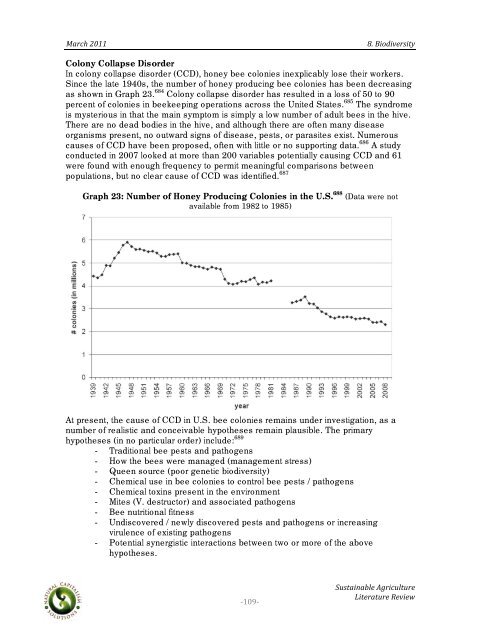Sustainable Agriculture Literature Review - Boulder County
Sustainable Agriculture Literature Review - Boulder County
Sustainable Agriculture Literature Review - Boulder County
Create successful ePaper yourself
Turn your PDF publications into a flip-book with our unique Google optimized e-Paper software.
! !!<br />
"#$%&!'())!! !!!!!!!!!!!!!!!!!!!!!!!!!!!!!!!!!!!!!!!!!!!!!!!!!!!!!!!!!!!!!!!!!!!!!!!C+!D.-E.;1$4.2F!<br />
Colony Collapse Disorder<br />
In colony collapse disorder (CCD), honey bee colonies inexplicably lose their workers.<br />
Since the late 1940s, the number of honey producing bee colonies has been decreasing<br />
as shown in Graph 23. 684 Colony collapse disorder has resulted in a loss of 50 to 90<br />
percent of colonies in beekeeping operations across the United States. 685 The syndrome<br />
is mysterious in that the main symptom is simply a low number of adult bees in the hive.<br />
There are no dead bodies in the hive, and although there are often many disease<br />
organisms present, no outward signs of disease, pests, or parasites exist. Numerous<br />
causes of CCD have been proposed, often with little or no supporting data. 686 A study<br />
conducted in 2007 looked at more than 200 variables potentially causing CCD and 61<br />
were found with enough frequency to permit meaningful comparisons between<br />
populations, but no clear cause of CCD was identified. 687<br />
!<br />
Graph 23: Number of Honey Producing Colonies in the U.S. 688 (Data were not<br />
available from 1982 to 1985)<br />
At present, the cause of CCD in U.S. bee colonies remains under investigation, as a<br />
number of realistic and conceivable hypotheses remain plausible. The primary<br />
hypotheses (in no particular order) include: 689<br />
- Traditional bee pests and pathogens<br />
- How the bees were managed (management stress)<br />
- Queen source (poor genetic biodiversity)<br />
- Chemical use in bee colonies to control bee pests / pathogens<br />
- Chemical toxins present in the environment<br />
- Mites (V. destructor) and associated pathogens<br />
- Bee nutritional fitness<br />
- Undiscovered / newly discovered pests and pathogens or increasing<br />
virulence of existing pathogens<br />
- Potential synergistic interactions between two or more of the above<br />
hypotheses.<br />
"'&$"<br />
!,342#.5#6/1!78$.%3/23$1!<br />
9.21$#23$1!:1;.1
















